Reportage

In the Cold War geopolitical setting, Bangladesh's relationship with the People's Republic of China (PRC) initially was not very positive, particularly in the context of the 1971 War of Independence. China, a trusted ally of Pakistan, did not stand beside Bangladesh (then East Pakistan) in 1971 and later used its first veto in United Nations Security Council to restrict the entry of Bangladesh into the United Nations as a permanent member. With the change in the domestic political landscape in 1975, Bangladesh's foreign policy priorities changed and so did China's perspectives towards Dhaka. Since the inception or normalisation of Bangladesh-China relations, the story regarding the two countries' bilateral relations is different from its past. Bangladesh-China relations grew on wider issues after the 1990s (Hossain 2021, 326). Frequent high-level visits by Bangladeshi presidents, prime ministers and leaders of the opposition reflected the importance of China in Bangladesh's foreign policy. Bangladesh's relations with China are rooted in a wide spectrum of areas, including deep political relations, economic ties, development assistance, people-topeople connectivity and defence and security. Bangladesh celebrated and recognised the friendship between the two countries by printing the Bangladesh-China Friendship Postal Stamp in 2000, and the year 2005 was declared the 'China-Bangladesh Friendship Year'. Bangladesh's relations with China have flourished since President Xi's visit to Bangladesh when Dhaka decided to join the Belt and Road Initiative (BRI) in 2016. Bangladesh, like most other developing countries, saw the enormous potential of the BRI in improving the infrastructure, connectivity and bringing the economic benefits necessary for a country that aspires to reach a developed country status by 2041. Bangladesh's relations with China soon turned into a widely cited example of a partnership between a developing and developed country in a global power rivalry setting. Over time, the bonding has turned China into Bangladesh's one of closest allies. However, some twenty-first-century challenges have the potential to turn out to be a matter of disagreement between the two counties if not addressed.
Against this backdrop, this chapter primarily aims to explain Bangladesh's foreign policy attitude towards China in the twenty-first century. The chapter is divided into seven sections. First, it discusses the different theoretical sources of a state's foreign in the light of theories of international relations. Second, to set the ground, the chapter briefly explains the foundations and principles of Bangladesh's foreign policy. Third, the chapter presents a historical overview of the evolution of Bangladesh's relations with China from 1971 to 2000. The fourth section provides the accounting of multidimensional Bangladesh-China relations in the twenty-first century. In the fifth section, the chapter provides an analysis of what shapes Bangladesh's foreign policy towards China in the twenty-first century. In the sixth section, the chapter outlines the contemporary challenges of Bangladesh's relationship with China. The last and seventh segment concludes by summarising the major debates and arguments discussed in this chapter.
Theoretical Basis: Sources of State Foreign Policy Behaviour Scholars in the domain of international relations (IR) have long debated the source of a state's foreign policy. However, there is a lack of mutual consensus on this matter. Scholars have approached questions of what determines a state's foreign policy by branching out into the Aussenpolitik School, the Innenpolitik School and the integrative/inclusivist perspective e (see Chakma 2015).
The Aussenpolitik or international school of thought reflects the idea that primary source of an actor's foreign policy is based in international politics. This school of thought mostly aligns with the neorealist branch of realism. Kenneth Waltz (1979), the father of neorealism, states that the international system determines an actor's behaviour. In neorealism, only the structure of the international system determines the state's behaviour, while domestic aspects are insignificant. Aussenpolitik's liberalism can be understood from actors' foreign policy and liberal institutionalism. Keohane and Nye's book (1977) started the impact of international regimes. With the help of complex interdependency liberalism, international regimes facilitate setting agendas of global politics and allowing disagreements to be resolved at a lower cost.
The Innenpolitik school of thought argues that domestic/ internal politics dynamics determine an actor's foreign policy. Under the principle of democratic peace theory, liberalism preaches the idea that two similar like-minded powers (democracies) have little interest in conflict and contest. The Innenpolitik school inclusion of political parties and leaders' ideology, interest, social structure or historical past is rooted in constructivist explanations. Another theory which falls under the Innenpolitik school of thought is Marxism. Lenin (1916) argued that the cause of international conflict is rooted in a state's socio-political or economic structure but not due any systemic issues.
Some theorists believe it is neither internal nor internal factors that determine the foreign policy of an actor, but that such policy is rather a by-product of both. One of the earliest scholars of the integrative perspective is the Robert Putnam (1988), who argued that international negotiations reflect the importance of the inclusivity of domestic politics in international relations. In short, Putnam's work examines foreign policy decision bargaining between domestic and international levels. Neoclassical realism, unlike structural realism, is primarily interested in explaining the foreign policy behaviour of actors, not the outcome of international politics, which distinguishes it from other realists. While neoclassical realists agree with neorealists that the international system is mainly determinant of an actor's foreign policy motivations, unlike neorealists, they also emphasise the unit-level variable (domestic politics) shapes foreign policy decisionmaking (Ripsman Taliaferro and Lobell 2016). Neoclassical realists also emphasise the role of political elites with reference to ideological perspectives in determining states' foreign policy.
Bangladesh's foreign policy and its relations with the PRC are unlikely to be entirely dependent on either the international environment or the internal domestic political landscape. Following the theoretical standpoint of the Aussenpolitik and Innenpolitik schools is unlikely to lead towards a comprehensive and nuanced understanding of Bangladesh's relations with the PRC. For Bangladesh, several factors might determine its relations with the PRC, including historical factors, geographic location, security and safeguarding sovereignty, economic needs and the quest for development. Beyond the tangible and materialistic explanations, values, ideological perceptions and views of political parties and elites are likely to have some impact. Therefore, the integrative/ inclusivist school of thought, which accommodates both the external and internal dynamics, would be most appropriate approach to unpacking Bangladesh's foreign policy towards the PRC.
The Foundations and Principles of Bangladesh's Foreign Policy: A Brief Overview
With more than 50 years of experience, the foreign policy of Bangladesh has turned out to be an interesting case for consideration. Bangladesh's foreign policy has undergone several phases since the country gained independence in 1971 (Ahmed 2016: 369). The transformation in Bangladesh's foreign policy can be understood alongside its changes in political regime and the global political landscape. The national interest and the domestic political scenario mostly shape the foreign policy of Bangladesh. Articles 25, 63 and 145(A) of the Constitution of Bangladesh set the basic principles of Bangladesh's foreign policy (The Constitution of the Peoples Republic of Bangladesh). While Article 25 emphasises the promotion of international peace, security and solidarity, article 63 relates to the condition of declaring war and article 145(A) talks about international treaties (Hassan 1989, 2-4).
The foreign policy objective of Bangladesh is shaped by the principle of friendship towards all and malice towards none. According to a former foreign minister of Bangladesh and a veteran diplomat, Bangladesh's foreign policy is shaped by two broader aspirations: first, the quest to ensure and preserve the country's sovereignty; second, the search for resources leading to the country's development and economic welfare (Chowdhury 2011, 3).
Ensuring and safeguarding its national security, along with the geographical considerations of being mostly surrounded by India and rising tension along the Myanmar border, shapes Bangladesh's foreign policy. Bangladesh, a developing economy, specialises on enhancing trade, attracting foreign direct investment and promoting economic cooperation. The desire for economic development has recently led Dhaka to concentrate on economic diplomacy (The Business Standard 2022). In achieving such foreign policy objectives, Bangladesh actively takes part in international multilateral institutions such as the United Nations (UN), the World Trade Organisation (WTO), the Asian Development Bank Commonwealth of Nations, the Organisation of Islamic Cooperation and regional institutions such as South Asian Association for Regional Cooperation (SAARC) and the Bay of Bengal Initiative for Multi-Sectoral Technical and Economic Cooperation (BIMSTEC). Over time, Dhaka's Foreign Policy has started to reflect maturity in its foreign policy, with an ability to say 'NO' when needed and required (Yasmin 2022).
The Origins of Bangladesh's Relations with China: A Historical Outlook (1971 to 2000)
The beginning of Bangladesh-China relations was complicated and not smooth. The crisis regarding the independence movement of Bangladesh (then East Pakistan) led by Sheikh Mujibur Rahman's Awami League along with the political support from New Delhi and its growing indifference towards West Pakistan was the cause of deep consideration in China. China's view towards Bangladesh's independence movement was shaped by its regional geopolitical rivalry with the Soviet Union and the threat of India stemming from the Border War of 1962. The regional geopolitical context made the PRC seek a united Pakistan to help counterbalance its own threats. China view towards Pakistan's military's crackdown on the Bengalis in 1971 was shaped by the idea that this was an internal domestic matter for Pakistan and that the country had the right to safeguard its sovereignty from Indian expansionist desire. However, in resolving the conflict, Chinese premier Zhou encouraged East Pakistan to solve the differences with continuous engagement with the Awami League (Chowdhury 2012, 53).
Upon the India-USSR Friendship Treaty and New Delhi's direct military intervention in East Pakistan (now Bangladesh) in December 1971, Beijing took a strong voice in favour of Islamabad. Against this backdrop, even after the end of the Liberation War, the PRC blocked Bangladesh's admission to United Nations with their first veto in United Nation's Security Council (Yasmin 2009, 74). The PRC's position toward Bangladesh only started to soften after numerous Islamic countries, including Pakistan, recognised Bangladesh in early 1974. Sheikh Mujibur Rahman (known as Bangabandhu, meaning Friend of Bengal) and his government realised the necessity of diversifying the international recognition of the newborn country and made several efforts to establish official ties with the PRC. Despite good success in achieving diplomatic recognition worldwide, Bangladesh did not see any success with the PRC during Mujib's era.
The PRC's official recognition of Bangladesh came on 1975, and the establishment of bilateral relations in early 1976. Former President Ziaur Rahman made the first high-level visit to the PRC in January 1977. In return for the invitation, Chinese Vice President Li Xiannian visited Bangladesh in March 1978. These high-level bilateral visits helped both sides overcome their previous uncordial relationship, which led to them concentrating on expanding bilateral ties. Soon after Zia took over the president's office, Bangladesh grew indifferent with India because of Farakka Barrage issues, where Dhaka accused India of seeking to divert the Ganges River water upstream (Chowdhury 2012: 59). The PRC's views towards the USSR, India and Bangladesh's domestic political landscape shaped Bangladesh-China relations initially. Zia's presidency was instrumental in improving the relationship with the PRC and the West by departing from Mujib's close alignment policy with India and the Soviet Union. During Zia's tenure, Bangladesh and PRC signed an agreement of cooperation in economy, science and technology, culture, bilateral loans and aviation transport (Harun ur Rashid cited in Sarker 2014, 75). The good relationship established with the PRC during the Zia's tenure paved the path for another military leader, President General Hossain Mohammad Ershad. The successive two military background leaders made Bangladesh a major procurer of Chinese military hardware, including fighter aircraft. The PRC also helped establish the only arms-making factory in Bangladesh, known as the Bangladesh Ordinance Factories, in Joydebpur. During Ershad's presidency, the PRC also started to have the largest involvement in foreign direct investment in Bangladesh (Datta 2021, 175). The trend of high-level mutual visits continued throughout the 1980s, which forged closer political, economic and defence ties and numerous trade and arms supply agreements.
Even after democracy returned to Bangladesh in 1991, the two subsequent governments led by Khaleda Zia's Bangladesh's Nationalist Party (1991-1996) and Sheikh Hasina's Bangladesh Awami League (1996-2001) continued Bangladesh's positive relations with the PRC. One of the main reasons Bangladesh had positive perceptions towards the PRC even in the 1990s was because the multiple changes in Bangladesh's government never impacted Beijing's attitude towards Dhaka. After the democratic transition in Bangladesh, PRC President Yang Shangkun expressed his willingness to continue its close relations based on mutual respect, equality and benefit (Beijing Review 1991, 6). In the post-Cold War era, with changes in the global and regional setting, the PRC became a key partner of Bangladesh in all dimensions of bilateral ties (Hossain 2021, 326), which helped to overcome Indo-centrism (Morsalin 2019, 399). Frequent high-level political and official visits between Bangladesh and the PRC resulted in the signing of multiple agreements, memoranda of understanding and economic deals. Despite the high number of defence purchases, the economic domain became the central area of bilateral relations between Bangladesh and China in the 1990s. Development initiatives like infrastructure and connectivity was also part of Dhaka-Beijing relations in the twentieth century; for example, four Bangladesh-China Friendship Bridges were constructed and the Bangladesh-China Friendship Centre was built.
Accounting for Bangladesh's Relations with China in the Twenty-First Century: The Era of Robust Cooperation
The rise of China as a regional and global power and Bangladesh's economic development paved the way for strategic diplomatic relations between the two in the 21st Century. The frequent visit of the head of state and opposition leaders of Bangladesh to China indicates the priority of Beijing in Dhaka's foreign policy. Even though the economic cooperation started right after the diplomatic recognition of Bangladesh by China, the level of development and financial cooperation deepened with the inception of the Belt and Road Initiative (BRI). With President Xi's visit to Bangladesh in 2016, Bangladesh became part of BRI. Both countries signed 27 agreements and a Memorandum of Understanding (MoU), among which were USD 26 billion on bilateral assistance and USD 14 billion for joint venture projects (The Daily Star, 2019), US$ 20 billion in loan agreement to join China's grand strategy BRI (Khatun and Saadat 2020, 3). No country has ever made such high scale investment in the history of Bangladesh. The visit of President Xi has upgraded Bangladesh-China relations from 'Close Comprehensive Partnership of Cooperation' to a 'Strategic Partnership of Cooperation' (Chakma 2022, 183). Numerous notable infrastructural projects under BRI include the Padma Bridge Rail Link Project, the Dhaka-Sylhet four-lane highway project, the construction of a tunnel under the Karnaphuli River, the development of the national ICT infra-network project for the Bangladesh Government and so forth. Since 2016, only seven projects worth $5.4 billion have been signed and only 1.54 billion has been distributed till 2021 (The Daily Star, 2021). The delay of project loan approval from Chinese authorities is delaying project implementation, ultimately causing numerous revisions and increasing the overall cost. Overall, between 2009 and 2019, China invested USD 9750 million in various transportation projects in Bangladesh (Sadat and Khatun 2019, 3).
This infrastructural development is a good opportunity for Bangladesh to increase trade and commerce. Also, infrastructural projects are vital for Bangladesh as this increases internal connectivity from one part of Bangladesh to another and reduces the traffic congestion on highways and railways. Strategically, China considers Bangladesh as a gateway for its Maritime Silk Road (one component of the BRI) and gives China access to the Indian Ocean, which is close to its regional rival India. China previously has shown a firm interest in financing a deep seaport at Sonadia, Bangladesh. However, India, the US and Japan's objection played a role in Dhaka scrapping the Sonadia deep-sea project. However, this did not stop Bangladesh from taking the geopolitical advantage of welcoming Japanese funding for the Matarbari deep-sea port, which Tokyo says falls under its Free Indo-Pacific Initiative vision (New Age 2021).
Bangladesh for a long in the past has suffered from an energy shortage. Old gas-powered power plants were incapable to generate energy as per Bangladesh's demand (Rao 2011). China's assistance in Bangladesh's energy sector is not something new; examples include the construction of a Boropukuria power plant and a nuclear power plant in the pre-BRI period. Bangladesh's largest 1320-megawatt Payra coal-powered power plant is a prime example of China's involvement in Bangladesh's energy sector. Other Chinese investments in Bangladesh's energy sector include a 1300 MW power plant in Chottogram (Hossain 2021, 330) and a 1300 MW coal project in Cox Bazar (Siddique 2019). Around fifty-six per cent of China's total investment in Bangladesh is in the energy sector, and most are in coalfired power plants (Global Infrastructure Hub 2019). Undoubtedly, China's contribution has helped Bangladesh to certain extend overcome the energy shortage it has suffered for long. However, Coal shortage has sometimes cause disruption in these power generation like in Payra Power Plant (Dhaka Tribune 2023). Such large investment in the coal-based energy sector raised concerns about adverse effects on the climate and environment. Realising the need and not 'missing the bus', China told Bangladesh it would not fund future projects that negatively impact climate but take steps to fulfil sustainable Belt and Road investment.
Bangladesh's good debt management has ensured it does not turn out to be a source of anxiety. Research shows that the debt owed to China is not big enough for Bangladesh to be caught in a debt trap (Pal 2021, 48), nor does it appear to be confronting an unmanageable debt burden (Chowdhury 2023, 25). Also, Bangladesh has shown agency by cancelling five commercially non-viable projects under BRI (Dhaka-Sylhet Four Lane Highway Project, Pre-paid metering project for BPDP's distribution zone, Gazaria 350 MW coal-fired power plant, BMRE of jute mills of Bangladesh Jute Mills Corporation and Extension of the underground mining operation of Barapukuria) amounting to US$3.6 billion in total (Daily Star 2021). Bangladesh has demonstrated merit in its assessment and decisionmaking regarding Chinese-financed BRI projects. However, getting involved in too many loan-based projects might change the Bangladesh's economic condition in the following years, for which Bangladesh must be extra cautious and calculative.
Another notable area of Bangladesh-China friendlier relations is public health. China's assistance in developing the health sector goes back even before Bangladesh became a party to BRI and the global outbreak of Covid-19. A Chinese naval hospital ship visited Chattogram and provided treatment in 2013 (The Daily Star, 2013). In 2015, the PRC provided medical equipment worth USD 4.1 million to Bangladesh (Prothom Alo, 2015). With the outbreak of Covid-19 in the PRC, Bangladesh sent different/various kinds of medical accessories consisting of hand sanitisers, masks, gloves, protective gowns and caps (Bangladesh Post 2015). The PRC has actively supported Bangladesh with medical equipment like protective gear, testing kits, medical gloves and others throughout the pandemic. Upon Bangladesh's request, the PRC sent a professional medical team to manage the initial pandemic response with expert advice and treatments. A good proportion of people in Bangladesh are vaccinated with Chinese Covid-19 vaccines. When the Serum Institute of India failed to deliver as per pre-paid government vaccine orders, anti-India sentiment grew in Bangladesh (Anwar 2022, 21). The PRC also funded a project under China's South-South Cooperation Assistance Fund to reduce maternal mortality in Bangladesh, administrated by Partners in Population and Development (PPD), an intergovernmental initiative and Bangladesh's Ministry of Health and Family Welfare. In 2023, construction started of a joint venture of China-Bangladesh joint venture medical college and hospital in Northern Bangladesh (The Financial Express, 2023) and an agreement was signed between the two countries on the 'Implementation Agreement of China-Aid Project of Burn Unit of Chittagong Medical College Hospital in Bangladesh' (Chinese Embassy in Bangladesh 2023).
Another area in which Bangladesh and China have expanded their bilateral relations in the 21st century is by increasing their cooperation in the educational and cultural domains. Bangladesh-China educational and cultural relations have boomed since Bangladesh joined the BRI. Recently, China has increased the number of higher education scholarships, training courses, symposia, and cultural exchange programs available for university students and government officials. Also, there has been an increased desire of Bangladesh students to study in China due to increased funding opportunities, even in good ranked educational institutions. Online Facebook groups such as 'China Scholarship Helpline-CSH' have become famous among Bangladeshi students seeking quality higher education at abroad. Also, cultural and educational cooperation has led to the setting up of numerous Confucius Institutes in renowned private and public universities promoting the Mandarin language among Bangladeshis (New Age 2018). Also, in-person and online learning platforms such as 'Zhong Meng Mandarin Learning School' and societies such as the 'We Speak Chinese Club' have provided a platform and created a sense of community among Mandarin-speaking people in Bangladesh. With Mandarin proficiency, students and young professionals can acquire interpreter jobs with a good monthly salary payment and other facilities in different Chinese-funded projects. Regular cultural programs and activities such as the China-Bangladesh Cultural and Art Night, Chinese New Year activities, cultural shows on Chinese life and society, and Chinese artists' entertainment shows are helping the two countries to take their bilateral relations to new heights. Bangladesh welcomes such involvement of China in the cultural and educational domain as it helps to understand each other better.
Think tanks and civil society initiatives also play an essential role in fostering Bangladesh-China Relations. Non-state actors such as the Bangladesh Enterprise Institute (BEI) arrange seminars such as 'China-Bangladesh Relations: One Belt and One Road Initiative' and the Bangladesh Institute of Peace and Security Studies (BIPSS) regularly organises the China-Bangladesh Cooperation Forum, and international conferences such as 'Asian Regional Conference on Belt and Road Initiative (BRI): Prospects and Challenges' help both countries to better understand each other.
China became Bangladesh's biggest trading partner in 2005, overtaking India (Datta 2022, 176); it also positioned itself as one of the most prominent players in the Foreign Direct Investment (FDI) sector. In the fiscal year 2021-2022, China's FDI in Bangladesh amounted to USD$ 940 million, making PRC the top foreign investor in Bangladesh. China's largest foreign direct investment (FDI), around USD 11,510 million, is seen in Bangladesh's power and energy sector between 2009 and 2019 (Sadat and Khatun 2019, 3). Bangladesh's government and its authorities are working hard to attract Chinese investments in Bangladesh. China is also setting up manufacturing industry in Bangladesh in special economic zones (SEZ), such as the Chinese Economic and Industrial Zone-2 in Chattogram. Apart from FDI, bilateral trade between the two countries has continued to increase. Bilateral trade increased 30 per cent annually in the first half of the 2000s, reaching USD 1.14 billion in 2003-2004 and USD 3.4 billion in 2007 (Datta 2022, 175). Trade volume increased by 58 % in the year 2022, which reflects very strong trading and commercial relations. Despite trade being heavily in favour of China (with a significant trade deficit for Bangladesh), the trade has constantly been rising over the last decade. Imports from China account for 34% of Bangladesh's total imports (Anwar 2019).
Despite having no free trade agreements, both countries agreed a tariff exemption for 97% of Bangladeshi goods to China's market in July 2020 (Observer Research Foundation 2020). Further, this duty-free facility was increased to 98 percent in 2022, supporting greater access to China's domestic market for export-oriented industries in Bangladesh (Embassy of China in Bangladesh). While Bangladesh has an International standard ready-made garments industry, China's technical knowledge and supply of machinery and IT help to establish mutually beneficial joint ventures. Beijing's purchase of a 25 % stake in the Dhaka Stock Exchange (DSE), outbidding the National Stock Exchange of India, shows the regional competition over influence between India and China. As the cost of labour is rising and the population is ageing in China, Beijing plans to relocate labour-driven initiatives abroad while trying to shift its focus towards high-tech and highend production. Hence, as Bangladesh provides a cheap labour force at a minimum cost, China can consider Bangladesh an offshore investment destination. However, Bangladesh must remember to ensure its economic security.
Defence and security are another area in Bangladesh's relations with China that has grown in the 21st century. Often overlooked, defence ties are integral to Bangladesh's growing relations with PRC. The most notable event in the defence and security relations was the signing of a defence agreement between Bangladesh and China in 2002 during then Prime Minister Khaleda Zia's visit to PRC (Uddin and Bhuiyan 2011, 11). It was the first defence agreement signed by Bangladesh with any other country. Also, PRC is the major supplier of military hardware for Bangladesh. According to a report published by Stockholm International Peace Research in 2020, Bangladesh is China's secondlargest buyer of military hardware and equipment. The majority of weaponry used by the Bangladesh Army, Bangladesh Navy and Bangladesh Airforce is of Chinese origin. In 2005 Bangladesh ordered 16 f-5BG fighters which started to be delivered in 2006. In 2006, Bangladesh received 65 artillery guns, 114 missiles and defence-related systems from PRC. Bangladesh prefers to buy Chinese weapons as they are much cheaper than Western and Russian weapons; on top of that, China provides a soft loan facility. Also, one of the main reasons is that Bangladesh, as a developing peace-loving nation, has limitations in allocating excessive spending to defence equipment to the detriment of spending on development activities. However, these limitations are not observed at the cost of ensuring or safeguarding its sovereignty. Bangladesh bought two submarines from PRC (Daily Star 2016), is a prime example of how protecting its safety and sovereignty is a foundation of Bangladesh's foreign policy. Despite Bangladesh and China having no hiccups in defence and security cooperation, Dhaka needs to learn to diversify its military procurement given the global and regional geopolitical situation.
Bangladesh also relies on PRC for military hardware maintenance. Beijing helped Bangladesh construct its first submarine base in Cox Bazar, BNS Sheikh Hasina. In 2014 the Bangladesh Army began upgrading its all-functional T-59 tanks with the help of Chinese assistance and renaming them Durjoy (Bangladesh Defence Analyst 2020). The upgrade has saved a significant amount of money, incurring 1/3 of the cost of buying similar new tanks. Apart from maintaining frequent high-level military personnel visits, officers of the armed forces taking part in numerous training and courses in Bangladesh and China have increased military-to-military cooperation. Security-level cooperation also includes working with law enforcement agencies. In March 2006, PRC donated equipment for the Bangladesh Police which reflects cooperation between the Ministry of Home Affairs Bangladesh and the Public Security Ministry of China (Sarker 2014: 64). Also, in 2018 both countries signed an agreement regarding training assistance of law enforcement agencies and providing arms and ammunition to the Bangladesh Police (Bangladesh Protodin cited in Pal 2021, 12).
Beyond bilateral relations, Bangladesh and China cooperate well in regional and multilateral institutions. In the 1990s, a platform was developed known as the 'Kunming Initiative', which later became the 'Bangladesh China India Myanmar (BCIM) Forum' formed to build economic corridors connecting sub-regions of South, Southeast and East Asia (Khatun and Saadat 2020, 3). Bangladesh also supported China's in acquiring an observer status in the 'South Asian Association for Regional Cooperation (SAARC)', while in return, Beijing supported Dhaka's admission to ASEAN Regional Forum (Choudhury 2012, 61). Also, at the UN, Bangladesh and China generally support each other whenever possible, except on the Rohingya Issue.
Analysis: Explaining Bangladesh's Foreign Policy Approach Towards China
The previous section summarises the growth of bilateral relations between Bangladesh and China throughout the twenty-first century. This section explain why Bangladesh holds a positive foreign policy with China in the twenty-first century.
Bangladesh's Quest for Development and Improving Economic Welfare
Bangladesh's development partnership with China is something that has been around for some time. As improving connectivity, infrastructural, energy and health sector development are necessary for a developing country like Bangladesh, Dhaka looks positively towards Beijing's development initiatives. From Bangladesh's perspective, China's development cooperation is overcoming poverty and gradually increasing its selfreliance (Datta cited in Datta 2021, 177). Being a populated country, Bangladesh faces the challenge of unemployment. China's massive investment certainly helps to create job scope for youths and professionals. As China continues to offer more duty-free access to Bangladeshi products, it provides certain hope of overcoming the massive trade gap. Also, good diplomatic connections between the two countries increase the FDI in Bangladesh. Also, the emergence of the BRI provided prospects to fulfil Bangladesh's desire for economic development. Being an emerging economy, Bangladesh desires to graduate from the group of Least Developed Countries by 2026 and aims to become an upper-middle income country by 2031 and achieve developed country status by 2041. The BRI can act as a catalyst for achieving such an aim. China's development initiatives and economic activities align with domestic political targets set by the Awami League, such as Digital Bangladesh and Vision 2021 and Smart Bangladesh Vision 2041. Bangladesh joining the BRI is mainly driven by economic motives; Dhaka might have other motives, such as solving the Rohingya refugee crisis and taking the geopolitical benefit of multiparous challenges from India (Uddin 2023, 134-135). According to the prime minister's international affairs adviser Gowher Rizvi, Bangladesh welcomed BRI as it fits into Bangladesh's national priorities (Prothom Alo English, 2019).
Political Parties and Political Elites' Views towards China
Bangladesh's major political parties and political elite generally hold a positive view towards the PRC. No political party is ever accused of being lenient or pro-China concerning being harmful to Bangladesh (Datta 2022, 173). This is not the case for the PRC, like the political tussle and rivalry between the Awami League and BNP regarding India. Instead, all political parties try to maintain an amiable relationship with the PRC. Following the trend of the 70s, 80s and 90s, all prime ministers of Bangladesh in the twenty-first century have visited the PRC during their time in office. Top Bangladeshi leaders also visited the PRC while not in power, such as Shaikh Hasina in 2002 and Khaleda Zia in 2016. The frequent visits by political elites have helped to establish robust bilateral relations. Bangladesh's relations with China in recent times have also created a stronger party-to-party relationship. In 2018, the ruling party, the Awami League, and the Chinese Communist Party (CCP) signed a memorandum of understanding to increase party-to-party ties (Dhaka Tribune 2019). Since then, high-level party-to-party visits have boosted from party-party to statestate cooperation. Despite the fact that the two major political parties, the BNP and the Awami League, often differ in their foreign policy stances, they tend to hold identical views regarding maintaining strong ties with China. Major political parties, including the Awami League, the BNP and leftist parties became part of Bangladesh China Silk Road Forum, which aims to facilitate China's Belt and Road Initiative (Bdnews24.com, 2019). Also, other major political parties in Bangladesh, such as the Jatiya Party and Bangladesh Jamaat-e-Islami do not hold any negative feelings towards China.
China's Positive Image
Generally, Bangladeshi people hold positive perceptions towards China. India continues to be seen as unfriendly in the eyes of some of the general public for several reasons, such as border killings and the Teesta River dispute. The case is different for China. According to a Pew Research survey conducted in 2014, 77 per cent of Bangladeshis view China positively (Pew Research 2014). In 2022, a survey conducted by the Centre for Genocide Studies of Dhaka University found that 14 per cent of the respondents held a very good impression, 46 per cent held a good impression, 36 per cent held a neutral view, while only 6 per cent held a negative attitude towards China (The Financial Express 2022). According to the former director of the Centre, 'the survey demonstrates that the respondents are more optimistic about the Chinese national image as a friendly country [and believe that] the Chinese people are friendly or peaceful' (The Financial Express 2022). However, Bangladesh is a Muslim-majority country, many people concerned regarding the status of Uighur Muslims in China and Beijing's role regarding Rohingya Muslims in Myanmar (The New Age 2022). Bangladesh's business community and military strongly advocate for stronger Bangladesh-China relations. Frequent high-level official defence visits, military procurement, training and courses create a cordial relationship between the two-armed forces. The supply of military equipment from China helps Bangladesh achieve its military modernisation plan, known as 'Forces Goal 2030'. Also, intelligentsia and thought leaders from Bangladesh like Professor Rehman Sobhan (the chairman of the Centre for Policy Dialogue), Faruq Ahmed Chowdhury (an author) and Ambassador Farooq Sobhan (the president of the Bangladesh Enterprise Institute) are good advocates of stronger ties with China (Chowdhury 2012: 63). Therefore, non-state or civil society actors also play a vital role in Bangladesh's relations with China.
China's Noninterference and Political Neutrality Regarding the Domestic Politics of Bangladesh
Another factor which acts as a positive force in Bangladesh's relations with China is Beijing's non-interference and maintenance of political neutrality regarding the domestic political landscape of Bangladesh. Despite whichever government is in power in Bangladesh, China has always shown a positive attitude to work hand-in-hand with the country. During the period of military-backed political leadership in the 1970s and 1980s, China has grown deep political relations with Bangladesh, maintaining political neutrality. Also, since democracy returned to Bangladesh in the 1990s and throughout the twenty-first century, the domestic political situation in Bangladesh has never turned out to be an issue for China. Unlike the US and India, China's non-interference and political neutrality positively improve Bangladesh's relations with the PRC. China even provides international support and recognition for the caretaker government of Bangladesh, which was in office between 2007 and 2009 (Chowdhury 2012, 61). If China continues to maintain its position of political neutrality in Bangladesh, it will likely bring even better relations between the two countries.
The Rocky Road: Challenges in Bangladesh's Relations with China in the Twenty-First Century
The key first challenge of Bangladesh's relations with China is the massive trade gap between the two countries. The massive trade gap has kept growing since the inception of bilateral relations between the two countries (Sarker 2014, 88). This unhealthy trade relationship has mostly paid dividends to the PRC. The PRC has made numerous efforts to reduce this big trade gap, like encouraging imports from Bangladesh and joint ventures in trade and commerce under duty-free access to 97%, later increasing to 98% of Bangladeshi products (Embassy of China in Bangladesh). With the help of the PRC, Bangladesh can decrease the trade gap by engaging both countries' business communities to arrange more frequent business fairs and information seminars.
Second, Bangladesh is facing the challenge of hosting millions of Rohingya refugees who came to Bangladesh due to the conflict between the Rohingya Muslims and Rakhine Buddhist communities in Myanmar. Despite the PRC's numerous assurances to help Bangladesh solve this pressing issue, this has not yet borne any fruit. If China maintains its current stance and Bangladesh continues to suffer, this issue could potentially damage China's positive image in Bangladesh (Anwar 2022, 22). Upon Bangladesh's request, China has agreed to help Bangladesh repatriate the Rohingya back to Myanmar. However, Dhaka believes that global geopolitics is impacting Beijing to do more in resolving the crisis as promised (Pal 2021, 15).
Third, China's desire to build more dams along the upper Brahmaputra River has become a severe concern for Bangladesh. At least 60% of the Bangladeshi population relies on the Brahmaputra's catchment basin (The Financial Express 2021). The Brahmaputra is one of the main sources of Bangladeshi livelihood mostly in the dry season. If Beijing fails to hear and understand such serious concerns from Dhaka, it can easily be a matter of downgrading both countries' relations.
Fourthly, with South Asia's greater importance, the US and China's competition in the Indo-Pacific Region has also reached Bangladesh. With the tension in US-Bangladesh relations, China has shown firm support towards the current Bangladeshi government against the US sanctions on its elite force, the Rapid Action Battalion, and the US' new visa restrictions. Ex-Chinese Ambassador Li Jiming's video message on Bangladesh's democracy led to discomfort and protests from the Bangladesh Nationalist Party (Prothom Alo English, 2021). Therefore, Beijing should follow its long-standing principle of non-interference in the domestic political affairs of Bangladesh. Also, ex-Chinese ambassador to Bangladesh Li Jiming's comment on the possibility of Bangladesh joining the US-led military alliance QUAD frustrated Dhaka deeply (Prothom Alo English, 2021). With such remarks and crossing the red line, it must be reemphasised that it would be wise for Beijing not to interfere in Dhaka's foreign policy decisions.
Lastly, corruption and violent unrest are sometimes reported from some Chinese-funded projects in Bangladesh. The China Harbour Engineering Company, a top construction company with operations in around 80 counties, was involved in corruption in Bangladesh. Bangladesh backlisted the China Harbour Engineering Company by offering five million Taka in bribes to the communication secretary (Bdnews24.com, 2018). Some reported cases of unrest have arisen from Chinese-funded projects in Bangladesh. In June 2019, factory worker unrest at Payra Power Plant started after a Bangladeshi factory worker died after falling into a boiler of the plant. In protest against safety negligence, Bangladeshi factory workers attacked the Chinese workers, killing one and injuring six others (United News Bangladesh, 2019). Another similar incident occurred in April 2021 at the S. Alam power plant in Banshkhali, where police had to open fire on a massive protest due to concerns over working conditions and facilities (The Daily Star, 2021). Therefore, precautions are necessary to avoid such incidents of worker unrest in the future.
Conclusion
Bangladesh's relationship with China has kept growing throughout the twenty-first century in almost every aspect: political, economic, defence and security. Bangladesh's desire to develop and improve its economic welfare is one of the main strategic rationales behind the continuous upgrading of its diplomatic relations with China. Also, one of the prime reasons behind Bangladesh's China positive foreign policy is to balance the asymmetric power dynamics between Dhaka and Delhi. As Bangladesh's relationship with China keeps improving, it pressures India to further improve its relations with Bangladesh. Unlike India and the US, China prefers to practice non-interference in Bangladesh's domestic affairs, which causes all political parties to hold positive perceptions towards China, despite their different political ideologies. Different stakeholders of Bangladesh's foreign policy formulation and the public mostly also consider China a trusted friend, positively impacting the two countries' bilateral relations. As bilateral relations are not dependent on Bangladesh's domestic politics or internal situation, this has never downgraded the cooperative mentality from both sides. However, as bilateral relations keep growing, Bangladesh has certain expectations from China in a multipolar world. As the popular saying goes, 'a friend in need is a friend indeed': if China can take a lead in resolving the Rohingya refugee crisis, this can be a game changer for future diplomatic relations between Bangladesh and China. China has shown its merit in solving critical geopolitical crises as a mediator, as can be seen in the case of Saudi Arabia and Iran. As Bangladesh reaffirms and stands firmly behind the 'One China' Policy, it reflects Dhaka's desire to maintain a cordial and friendly relationship with China in the future.
Raian Hossain is a Doctoral Researcher at the School of Politics and International Relations at the University of Nottingham (UK). Mr Hossain is also a lecturer (on study leave) at the Department of Global Studies and Governance, Independent University, Bangladesh. His research interests include Indo-Pacific Affairs, Geopolitics of South Asia and East Asia, Politics and Foreign Policy of Bangladesh, Terrorism and Preventing/Countering Violent Extremism.








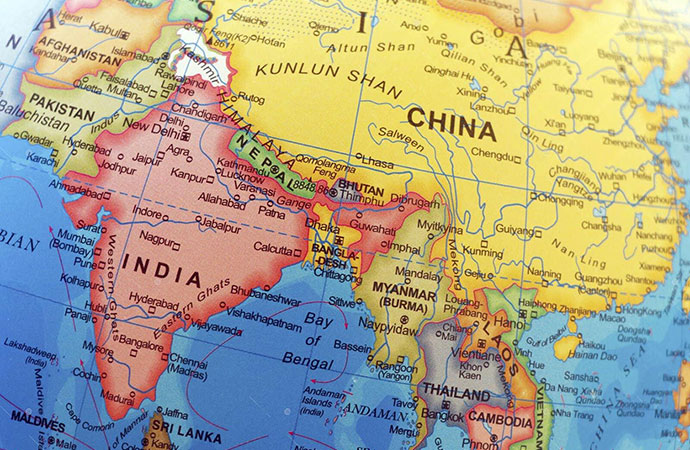

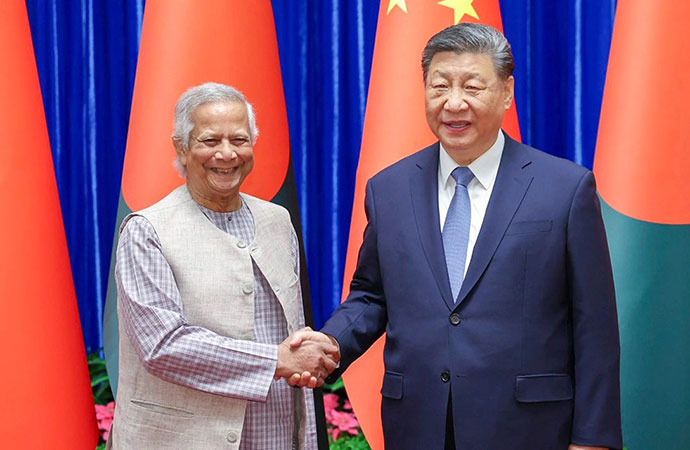

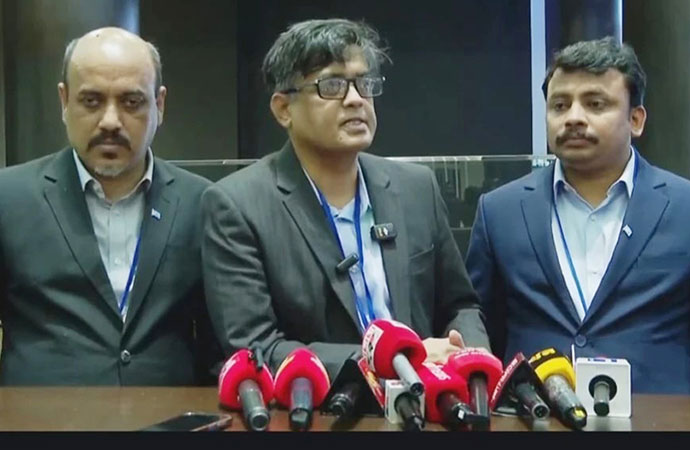




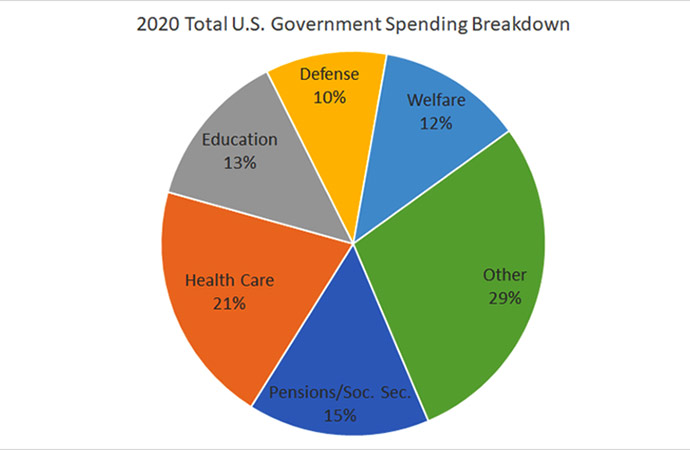
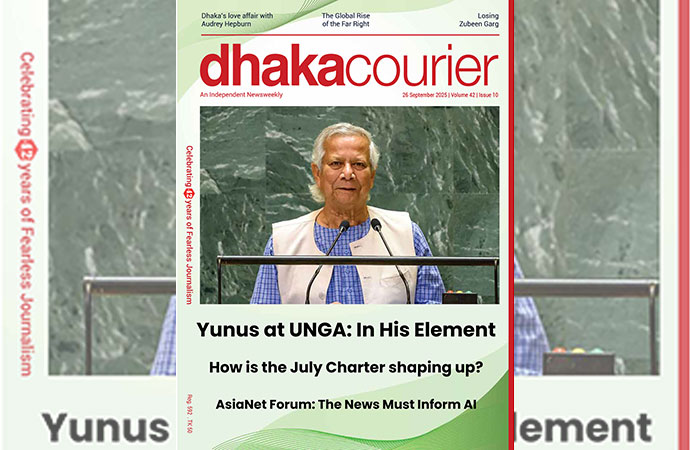
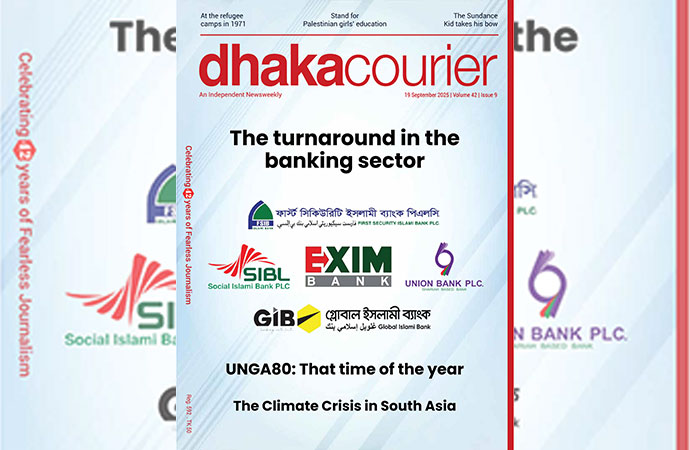
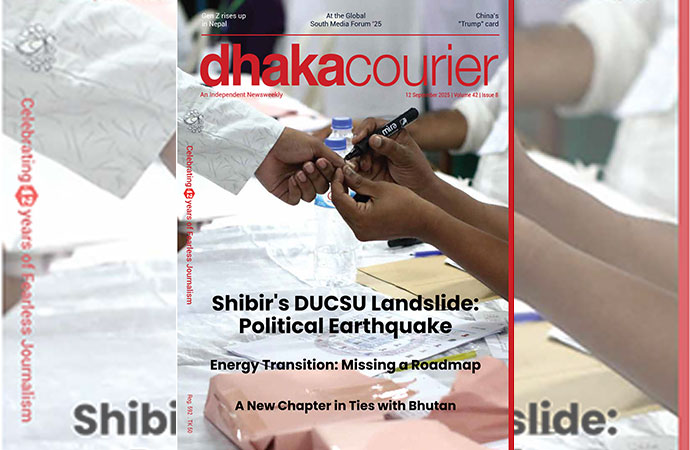
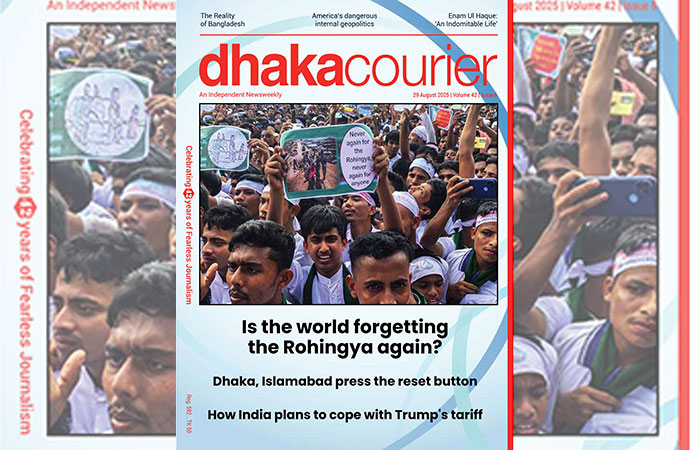

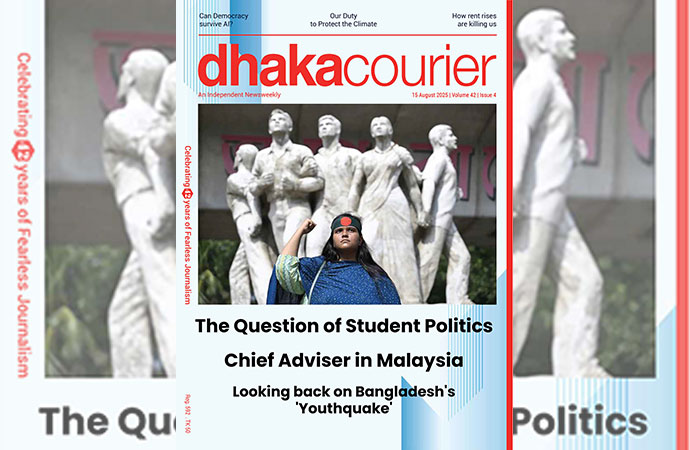
Leave a Comment
Recent Posts
Breakfast at Tiffany’s
Breakfast at Tiffany’s is an Old Hollywood film, released in 196 ...
Kalidas Karmakar’s ‘Holy War’ ...
Works of celebrated Bangladeshi masters, including Shilpacharya Zainul ...
All eyes on the Freedom Flotilla, as Shahidul Alam s ..
The disquiet in the Hills
Ocean Collective Summit 2025 Turning ‘What If’ into ..
Dhaka, Beijing should ‘deepen strategic partnership’ ..